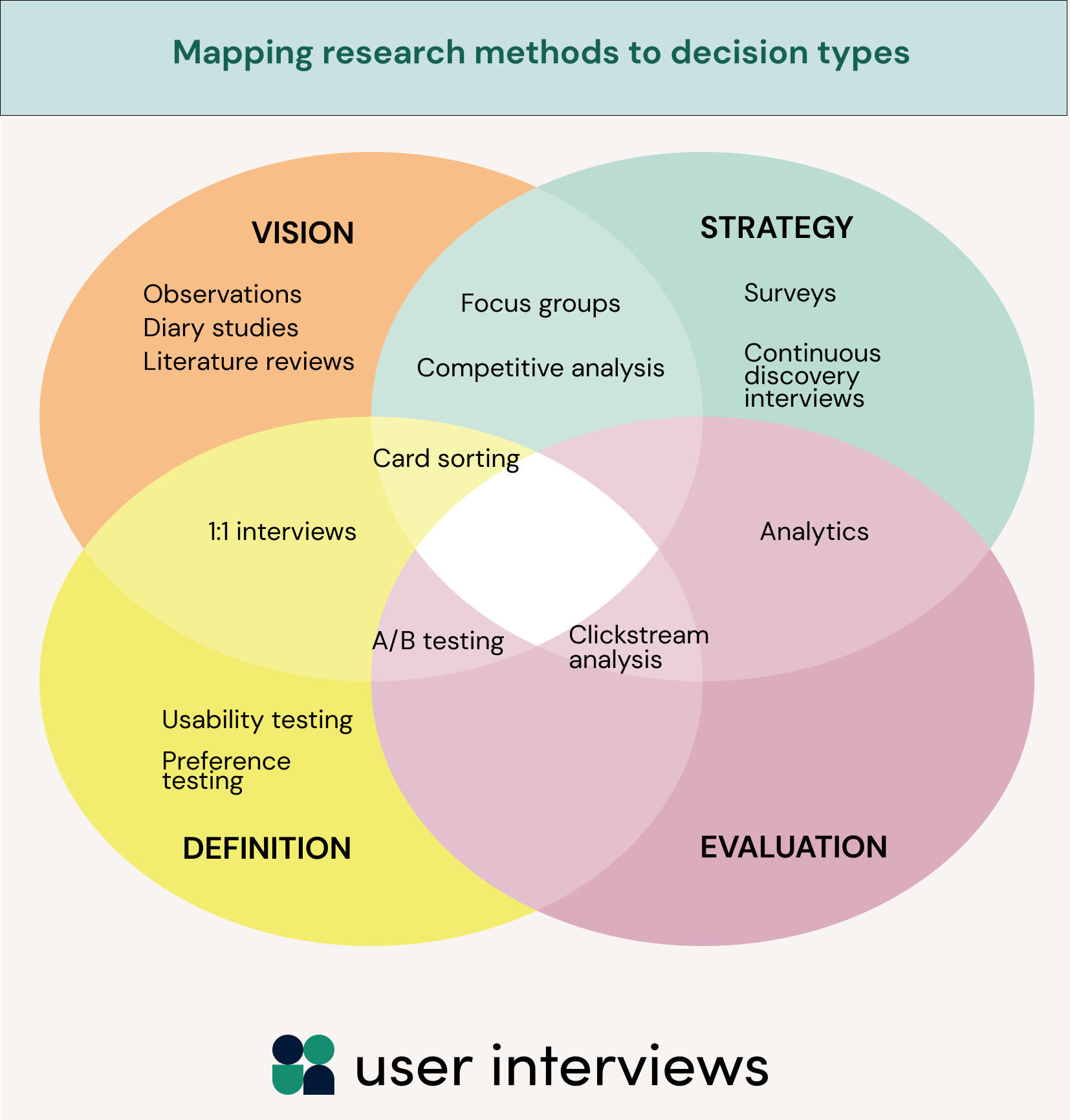The demand for UX has grown tremendously.
In fact, the percentage of people from organizations with five or more researchers (PwDRs included) has doubled from 36% in 2019 to 71% in 2022— and it’s not stopping anytime soon.
But as the demand for UX research grows, product and UX research teams are more overworked and under-resourced than ever. Effectively prioritizing research projects can help you make sure you're maximizing your impact without wasting time, money, or resources.
So what’s a good rule of thumb for determining when you should do UX research?
Roberta Dombrowski, the former VP of UX Research at User Interviews, created this framework in our UX research team’s internal playbook to help us learn how to do research that drives decisions and doesn’t waste time, money, bandwidth or resources.
What works for one organization may not always work for another, but we hope these guidelines can help you become more intentional, timely, and transparent with your research. Use this framework to learn what’s worked for us and apply similar guidelines to your own research.
In this article, you’ll learn:
- How we think about research at User Interviews
- What is “decision-driven research”?
- The 4 types of decisions research can inform
- The User Interviews’ map of research methods by decision type
- How to determine when research is not needed?
Research @ UI
Before we dive into the actual framework, let’s paint some context about how we think about research and how our research practice has evolved to this point.
When we officially formed the UX Research Team at User Interviews back in July 2021, we decided that this team should focus on working collaboratively to gather and interpret insights that help inform company-wide decisions. Since starting this team, we’ve done this by creating a shared understanding of our customers and their needs, motivations, and behaviors across User Interviews.
In addition to leading research projects, our UX Research Team also aims to enable PWDRs (people who do research who aren’t full-time UX researchers) like Product Managers, Product Designers, Marketing, Customer Success, etc. to conduct their own research with customers.
So how are we able to determine whether the research insights from the User Interviews’ UX Research Team actually helps drive business decisions? We’ve sharpened our focus on “decision-driven research.”
What is decision-riven research?
Decision-driven research is information collected through research that is used to inform company-decisions.
Just like many other organizations, our team is small and resources are limited—especially during a looming recession. We never want to do research for the sake of research. Rather, we want to make sure we’re collecting information that will be used to drive our business forward.
Focusing our research efforts on projects that we know will help us make better decisions for product, design, marketing, and the overall business strategy allows us to cut out unnecessary work.
Doing decision-driven research helps us evaluate the success and effectiveness of research by tying research projects back to the specific decisions we want to enable. This makes it much easier to track where, when, and how user research is contributing to company goals.
According to the User Interviews’ 2022 State of User Research Report, people who don’t track the impact of their research were notably less satisfied with how research is used to make decisions at their company compared to people who do, rating their satisfaction 2.61/5 versus 3.56/5.
Tying our research efforts back to the bottom line goals we want to achieve provides a clear path and purpose that makes tracking the impact of research easier.
Our philosophy is to talk to your users all the time, but the caveat that helps keep our research on track is to do it at the right time, with the right people. Talk to your users as much as possible, but make sure you understand why you are doing it and how those conversations can help your immediate or long-term needs.
📕Need help navigating budget cuts and uncertainty? Here are 5 Ways to “Recession-proof” Your 2023 User Research Plan.
4 types of decisions research can help inform
UX research can be used to inform different types of company-wide decisions.
Here are the 4 types of decisions that research can inform:
1. Vision
Using research to drive vision decisions means to provide clarity on why a product or solution exists. It also means understanding customers' big-picture beliefs and philosophies to inform opportunities to develop overall company, product, or service direction.
The research methods that can help drive vision decisions include: observations, diary studies, literature reviews, focus groups, competitive analysis, card sorting, 1:1 interviews, and A/B testing.
2. Strategy
Sometimes, it’s difficult to define your next steps in your product, design, marketing, and overall business strategy. UX research insights can help you paint a clear picture about customers’ behaviors, expectations, or frustrations to help determine a plan of action for a current product or service.
Research methods that are useful for understanding your users’ sentiment, behaviors, pain points and other user insights are surveys, continuous discovery interviews, analytics, clickstream analysis, focus groups, and competitive analysis.
3. Definition
Definition-type decisions involve the process of defining how customers may behave or interact with a potential solution. This involves testing certain features or different iterations with your users to define their reactions and behaviors, and then determining whether the idea is worth investing more resources or time into.
When you’re looking to test different features or products with users, try using these research methods to help you drive definition decisions: usability testing, preference testing, 1:1 interviews, A/B testing, card sorting, and clickstream analysis.
4. Evaluation
User research oftentimes focuses on the users’ behaviors, actions, emotions, and intrinsic motivations, but evaluation decision types involve evaluating the product or solution. Is this product better than the last? What aspect about the product is new? How can we gather data about the performance of this new iteration or new product?
Using specific research methods like A/B testing, clickstream analysis, or data analytics to make evaluation decisions can help you improve your solution.
User Interviews’s map of research methods by decision type

When is research NOT needed?
As huge advocates of research, we like to think that research is always important—and it is. But there are certain situations when conducting research isn’t the best option. Don’t do research just to do it; do research when it brings value to your organization in some way, whether it be monetary value, customer satisfaction, saved time, or any other factor that helps you determine the value of research.
So when should you not do research? Here are some questions to ask yourself before kicking off a new research project or asking for research support:
- Has the decision already been made?
- Does my team have agency to make the decision?
- Can we answer this research question by doing a Google search?
- Is the answer to this question, “yes” or “no”?
- Has this research been done before, either by myself or someone else?
- Am I conducting research only to get political buy-in?
If you answer “yes” to any of these questions then you may not need to conduct any qualitative research. These questions help you think more intentionally about the purpose of your research; why am I doing this research and is it worth my time to launch an entire study to answer this question?
💡Here’s a tip: Try building a healthy research repository of insights to help you lean on, remix, and reuse research projects that have already been done to help you avoid doing duplicate work.
Oftentimes you may still determine that research is needed but for some reason, budget, scope, or timing may not align for the work to happen. That is okay! It’s all an ongoing process of learning.
Rather than skipping out on research entirely when you feel like it’s not necessary, focus on delaying, rearranging, or reprioritizing your resources on other projects that may need more attention at that given moment.
In a nutshell, research is simply systematic inquiry. You can engage in research anytime you want to know more about a particular topic and go through a process to increase your knowledge in some way. Anyone can do research anytime they have a question about a specific topic.
For organizations and UX research teams that are constantly looking for the most efficient and timely ways to use research, they can use frameworks like this to help them identify the best time to do specific types of research.
Conducting user interviews at the right time
You can do research for almost anything, but doing it at the most optimal time to bring value to your organization is a skill that all UX researchers and PWDRs should work on. The best time to prioritize user research is when insights will be used to drive company decisions. Use the User Interviews’ framework as a starting point to guide your research for different company decision types.
✨Looking to talk to the right people at the right time? We can take that load off your shoulders. Connect to your target participants in a matter of minutes with User Interviews’ Recruit, or scale your research efforts seamlessly with our Research Hub.
Collaborating Author
Roberta Dombrowski is a (former) VP, UXR at User Interviews. Currently, she is a Design Leadership Instructor & Executive Coach at Design Dept.














.jpg)
.jpg)
.png)



